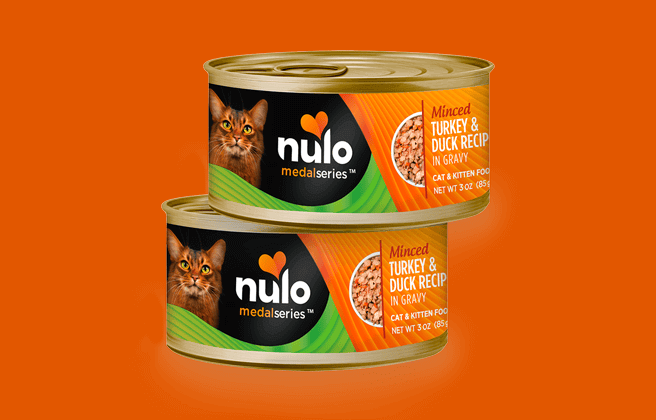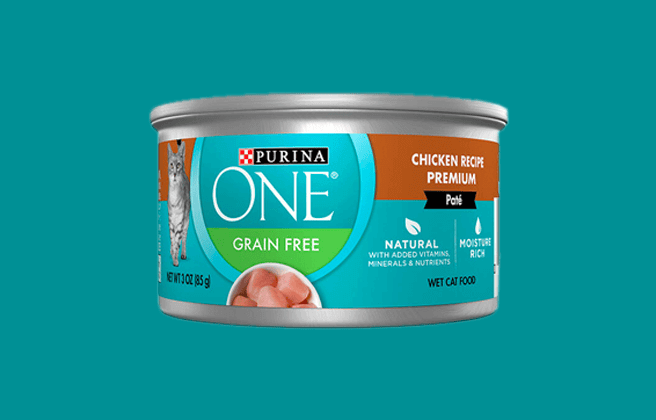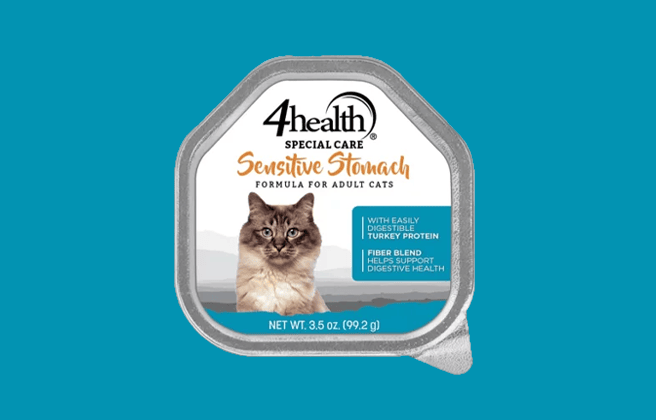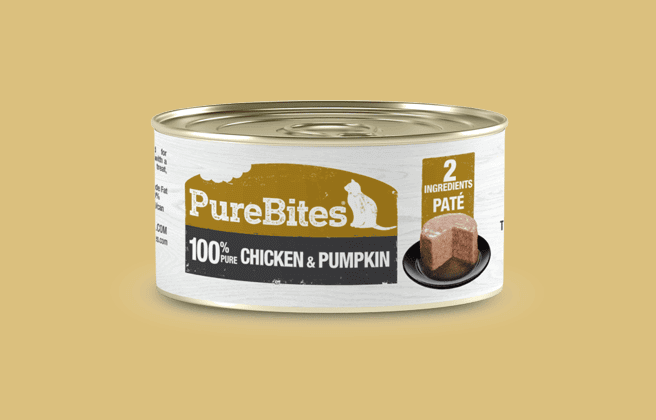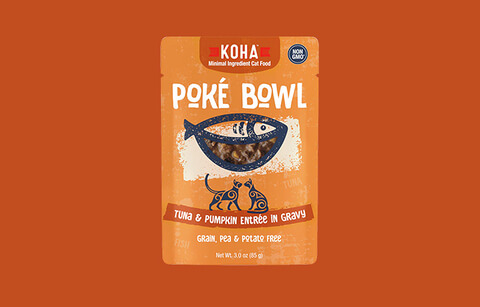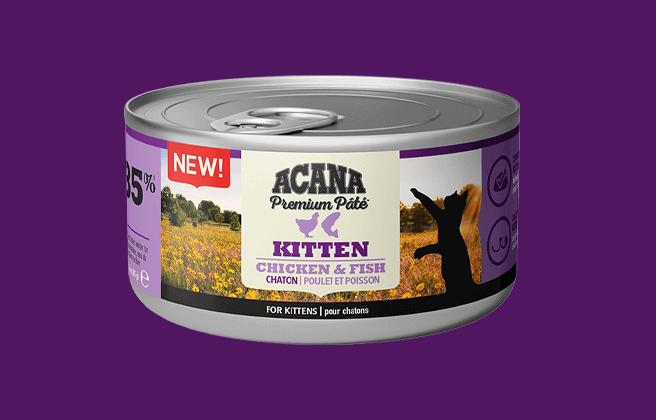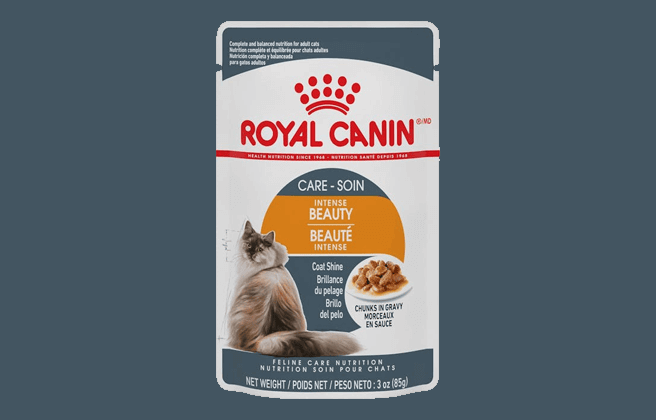
Our Verdict
Royal Canin wet cat product range is made of fourteen recipes which all receive the Cat Food Advisor rating, 2 stars.
Royal Canin has a variety of wet products tailored to a cat’s individual needs, whether they live indoors or are more adventurous explorers outside. However, we have marked it down, as many of the recipes contain a number of controversial ingredients.
Pros
- Primarily made from animal ingredients
- Free from artificial colors and flavors
- Unique tailored formulas for individual needs
Cons
- Contains animal by-products
- Contains wheat
- Contains artificial preservatives
The table below shows each recipe in the range including our rating and the AAFCO nutrient profile: Growth (kitten), Maintenance (adult), All Life Stages, Supplemental or Unspecified.
| Product line | Rating | AAFCO |
|---|---|---|
| Royal Canin Intense Beauty | 2 | U |
| Royal Canin Kitten - Thin Slices in Gravy (Canned) | 2 | U |
| Royal Canin Kitten - Loaf in Sauce (Canned) | 2 | U |
| Royal Canin Digest - Sensitive Loaf in Sauce (Canned) | 2 | U |
| Royal Canin Digest - Sensitive Thin Slices in Gravy (Canned) | 2 | U |
| Royal Canin Weight Care - Thin Slices in Gravy (Canned) | 2 | U |
| Royal Canin Urinary Care - Thin Slices in Gravy (Canned) | 2 | U |
| Royal Canin 12+ - Thin Slices in Gravy (Canned) | 2 | U |
| Royal Canin Mother and Babycat - Ultra Soft Mousse in Sauce (Canned) | 2 | U |
| Royal Canin Adult Instinctive - Thin Slices in Gravy (Canned) | 2 | U |
| Royal Canin Weight Care - Loaf in Sauce (Canned) | 2 | U |
| Royal Canin Feline Appetite Control Care - Thin Slices and Gravy (Canned) | 2 | U |
| Royal Canin Maine Coon Adult - Thick Slices in Gravy (Canned) | 2 | M |
| Royal Canin Persian Adult - Loaf in Sauce (Canned) | 2 | M |
Save up to 35%
with Autoship
See discount in cart
Recipe and Label Analysis
Royal Canin Intense Beauty Wet Cat Food was selected to represent the other products in the line for a detailed recipe and nutrient analysis.
Label and nutrient data below are calculated using dry matter basis.
Royal Canin Intense Beauty Wet Cat Food
Estimated Dry Matter Nutrient Content
Protein
Fat
CarbsCarbohydrates
Water sufficient for processing, chicken by-products, pork by-products, salmon meal, pork liver, pork plasma, natural flavors, pork digest, wheat gluten, wheat flour, vegetable oil, powdered cellulose, modified corn starch, fish oil, calcium sulfate, sodium tripolyphosphate, potassium chloride, calcium carbonate, carrageenan, choline chloride, taurine, vitamins [niacin supplement, cholecalciferol (source of vitamin D3), D-calcium pantothenate, DL-alpha tocopherol acetate (source of vitamin E), thiamine mononitrate (vitamin B1), biotin, pyridoxine hydrochloride (vitamin B6), riboflavin supplement, folic acid, vitamin B12 supplement], caramel, sodium carbonate, magnesium oxide, trace minerals [zinc sulfate, ferrous sulfate, zinc proteinate, copper sulfate, manganese sulfate, calcium iodate, copper proteinate, manganese proteinate], BHA, propyl gallate
Fiber (estimated dry matter content) = 2.1%
Red denotes any controversial items
Ingredients Analysis
The first ingredient is water, which adds nothing but moisture to this food. Water is a routine finding in most wet cat foods.
The second ingredient is chicken by-products, what’s left of a slaughtered chicken after all the choice cuts have been removed.
In addition to organs, this item can also include feet, beaks, undeveloped eggs and almost anything other than prime skeletal muscle.
The quality of this ingredient can vary, depending on the caliber of the raw materials obtained by the manufacturer.
The third ingredient is pork by-products, slaughterhouse waste. This is what’s left of a slaughtered pig after all the prime cuts have been removed. With the exception of hair, horns, teeth and hooves, this item can include almost any other part of the animal. 1.
Again, the quality of this ingredient can vary, depending on the caliber of the raw materials obtained by the manufacturer.
The fourth ingredient is salmon meal. Because it is considered a meat concentrate, fish meal contains almost 300% more protein than fresh fish itself. Fish meal is typically obtained from the “clean, dried, ground tissue of undecomposed whole fish and fish cuttings” of commercial fish operations. 2.
Less costly plant-based products like this can notably boost the total protein reported on the label — a factor that must be considered when judging the actual meat content of this cat food.
The fifth ingredient is pork liver. This is an organ meat sourced from a named animal and thus considered a beneficial component.
The sixth ingredient is pork plasma. Plasma is what remains of blood after the blood cells themselves have been removed. Plasma can be considered a nutritious addition.
The seventh ingredient is natural flavor. Flavors doesn’t give us much information about the particular ingredients included in this cat food for flavoring purposes.
We’re pleased that the flavorings used are natural, but more details are required to give any further information about these natural flavoring ingredients. Flavorings are used to make the foods more appealing and tasty for our cats.
The eighth ingredient is hydrolyzed pork, pork meat that’s been hydrolyzed or broken down into its component amino acids and fat. Hydrolyzed pork is highly digestible and (like other hydrolyzed ingredients) may be considered hypoallergenic.
From here the list goes on to include a number of other items. But to be realistic, ingredients located this far down the list (other than nutritional supplements) are not likely to affect the overall rating of the product.
However this recipe contains wheat gluten. Gluten is the rubbery residue remaining once wheat has had most of its starchy carbohydrate washed out of it.
Compared to meat, glutens are inferior plant-based proteins low in some of the essential amino acids cats need for life.
This inexpensive plant-based ingredient can significantly boost the total protein reported on the label — a factor that must be considered when judging the actual meat content of this cat food.
It also contains wheat flour, a highly-refined product of wheat milling. Like corn, wheat is an inexpensive and controversial cereal grain of only modest nutritional value to a cat. For this reason, we do not consider wheat a preferred component in any cat food.
Carrageenan can also be found in this recipe. Carrageenan is a gelatin-like thickening agent extracted from seaweed. Although carrageenan has been used as a food additive for hundreds of years, there appears to be some recent controversy regarding its long term biological safety.
The article, The Carrageenan Controversy, published in Scientific American, does a good job of addressing this topic.
Propyl Gallate is also in the recipe, this fat is preserved with propyl gallate, a synthetic agent capable of mimicking the female hormone, estrogen. The long-term affects of feeding such a substance must be questioned. A safe level of propyl gallate has not been reported for cats 3 so we recommend that it should be avoided.
And finally BHA, a preservative added to a wide variety of processed foods to keep them fresh can also be found in this recipe.. While it’s labeled as being safe in low doses, it has been shown to cause tumors in lab animals, however, a little BHA is unlikely to harm your cat.
This recipe receives a 2-star rating.
Save up to 35%
with Autoship
See discount in cart
Nutrient Analysis
Based on its ingredients alone, Royal Canin Intense Beauty Product Cat Food looks like a below-average wet product.
The dashboard displays a dry matter protein reading of 52.5%, a fat level of 11% and an estimated carbohydrate level of 28.5%, alongside a fat-to-protein ratio of 21%.
As a group, the brand features an average protein content of 49.5% and a mean fat level of 13.9%. Together these figures suggest a carbohydrate content of 28.6% for the overall product line, alongside a fat-to-protein ratio of 29%.
This means the Royal Canin wet product line contains above-average protein, near-average carbs and near-average fat when compared to typical wet cat food.
Final Word
Royal Canin is a fairly expensive brand, however this is a reflection more on the product analysis which is carried out, rather than the ingredients.
Royal Canin products are more of a veterinary precision approach, even for their “healthy cat” recipes. Their foods deliver the functions that they claim, but the ingredients used are not comparable to the natural “food” ingredients found in other brands.
Has Royal Canin cat food been recalled in the past?
Yes, Royal Canin has been recalled a few times in the past 15 years.
The last one was in January this year and was due to a mislabelling issue. For more information, visit our recall page.
In 2007, specific varieties of Royal Canin dry dog and cat foods were recalled because of potential melamine contamination.
The affected foods were;
- Royal Canin Veterinary Diet Canine Early Cardiac EC 22 dry dog food
- Royal Canin Veterinary Diet Canine Skin Support SS21 dry dog food
- Royal Canin Veterinary Diet Feline Hypoallergenic HP23 dry cat food
- Sensible Choice Chicken Meal & Rice Formula Senior dry dog food
- Sensible Choice Lamb Meal & Rice Formula Puppy dry dog food
- Sensible Choice Lamb Meal & Rice Formula Adult dry dog food
- Sensible Choice Lamb Meal & Rice Formula Senior dry dog food
- Sensible Choice Rice & Catfish Meal Formula Adult dry dog food.
For more details, visit the Dog Food Advisor recall page.
In 2006, the following products were recalled as they contained too much vitamin D:
- Royal Canin Veterinary Diet Canine Urinary SO dog food, 13.6 oz. cans, Codes 511A/B and 521 A/B, best by March 2007
- Royal Canin Veterinary Diet Canine Urinary SO dog food, 13.6 oz. cans, Code 525A, best by June 2007
- Royal Canin Veterinary Diet Canine Low Fat LF dog food, 13.6 oz. cans, Code 526A/B, best by June 2007
- Royal Canin Veterinary Diet Canine Calorie Control CC in Gel dog food, 12.7 oz. cans, Code 515B, best by April 2007
- Royal Canin Veterinary Diet Canine Calorie Control CC in Gel dog food, 12.7 oz. cans, Code 528A, best by July 2007
- Royal Canin Veterinary Diet Feline Sensitivity VR cat food, 5.8 oz. cans, Code 518A, best by May 2007
- Royal Canin Veterinary Diet Feline Calorie Control CC cat food, 5.8 oz. cans, Code 449A, best by November 2006
- Royal Canin Veterinary Diet Feline Calorie Control CC cat food, 5.8 oz. cans, Code 451A, best by December 2006
- Royal Canin Veterinary Diet Feline Calorie Control CC cat food, 5.8 oz. cans, Code 515A, best by April 2007
- Royal Canin Veterinary Diet Feline Renal LP cat food, 3 oz. pouches, Codes 519B and 522B, best by September 2006
- Royal Canin Veterinary Diet Feline Renal LP cat food, 3 oz. pouches, Code 526A, best by October 2006
- Royal Canin Veterinary Diet Feline Renal LP cat food, 3 oz. pouches, Codes 541A and 543A, best by February 2007.
You can view a complete list of all cat food recalls since 2021 here.
To stay on top of any cat food product recalls, sign up for our free email alerts, here.
About
Royal Canin was started back in the 1960s by veterinary surgeon Jean Cathary who lived in France.
The worldwide headquarters is in Southern France, and U.S. products are manufactured in company-owned plants in Missouri, South Dakota and Canada.
Best cat foods
We uphold the highest editorial standards when creating the authoritative content pet parents rely on and trust.
Every piece of clinical content on the Cat Food Advisor is reviewed by our certified Veterinary Advisory Board, which consists of licensed veterinarians and medically certified specialists.
Our reviews are completely independent; we are not paid by any pet food company to promote their products favorably. We do not accept money, gifts, samples or other incentives in exchange for special consideration. For more information see our Disclaimer & Disclosure page.






